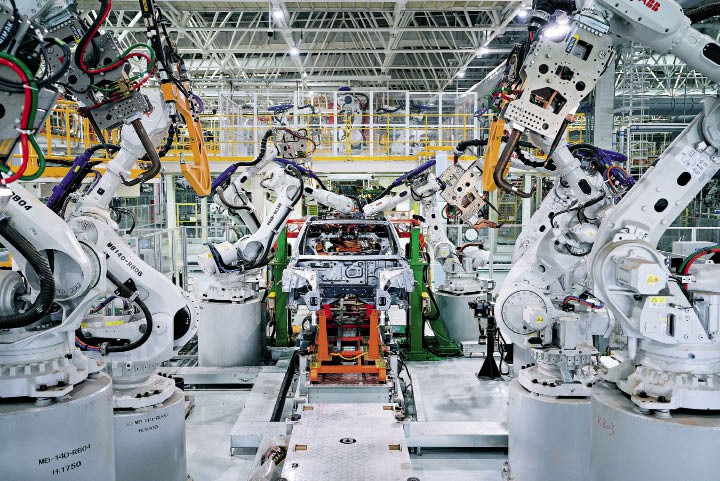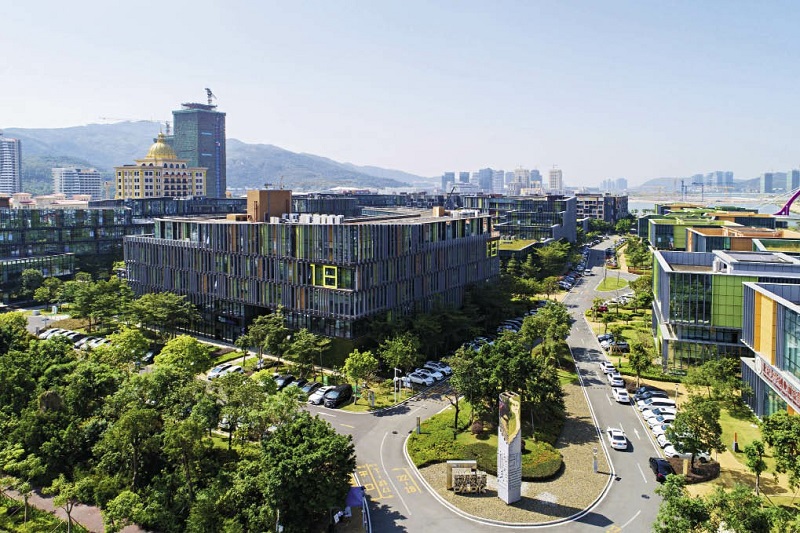“The Guangdong-Hong Kong-Macao Greater Bay Area occupies less than 0.6 percent of China’s territory but creates over 12 percent of the nation’s GDP. This means that the GDP generated on per square meter of the land may be 20 times that of the national average level,” said Zhang Guangnan, a professor at the Guangdong-Hong Kong-Macao Development Research Institute of Sun Yat-sen University. He further pointed out that different from the other three major bay areas in the world, each of the nine mainland cities plus Hong Kong and Macao in the Greater Bay Area has their own characteristics. The question of how to give full play to their respective advantages has become the key to achieving high-quality and coordinated development in the region.

A British visitor takes a photo of the pressure coffee machine produced by Guangdong Xinbao Electrical Appliances Holdings Co., Ltd.
Intelligent Manufacturing Plus Industrial Design
Where there is a home, there are “Made in Foshan” products. The output value of industrial companies with annual revenue of more than RMB 20 million in Foshan, an important industrial town in the one-hour commuter circle of the Greater Bay Area, reached RMB 2.33 trillion in 2020. As the number of world first-class designers attracted to Foshan increases, together with practitioners from Hong Kong and Macao, the city’s industrial design has moved to the forefront of the global industry.
In the factory of Guangdong Xinbao Electrical Appliances Holdings Co., Ltd., workers can be seen busily producing local-designed coffee machines on the assembly line. In the company’s showroom, all kinds of Internet celebrity products and small appliances can be seen on display, ranging from drinking cups with an automatic heating function and skin cleansing apparatuses, to toasters, grills, yogurt machines, and coffee makers. The British high-end home appliance brand Morphy Richards has reached a long-term strategic cooperation agreement with Xinbao to promote its high-end kitchen appliances in China.
Pan Lihong, deputy director of the president’s office of Xinbao, said, “We have in-depth cooperation with Internet companies such as Xiaomi and NetEase Yanxuan. In addition to this, we have strong independent research and development capabilities and a complete technological innovation system, with nearly 3,300 patents, including nearly 300 invention patents.”
In the Guangdong Industrial Design City in Foshan, the once abandoned factory has been transformed into a “national technology enterprise incubator,” representing the highest level of China’s industrial design. The number of industrial designers working on the campus grounds has expanded from 50 to 8,000, with another 40-plus independent brands. The industrial design city has cooperated with top institutions from the United States, Germany, Britain, France, Japan, Republic of Korea (ROK), and has established the China-ROK and China-France industry design cooperative centers. Some of the companies have won the Good Design Award in ROK and the International Design Excellence Awards in the United States.
On the campus, there is a one-square-meter kitchen, which displays for visitors various wireless portable kitchen appliances, such as portable electric juice cups, wireless smart pressure cookers, small stew pots, and multi-function pots. This is the world’s first mass-produced wireless kitchen built by Dr. Li Linghan, managing director of Foshan Charterhouse Electrical Appliances Co., Ltd.
“After years of research, our team has mastered the technology of 100-3,000 watts wireless power supply,” Li said, then added, “Within the next three years, we hope to become a more influential brand of intelligent home and kitchen appliances in the Asia-Pacific region, delivering wireless power supply kitchen appliances to more households.”
Incorporating cutting-edge technology into its smart manufacturing, Foshan is becoming a manufacturing innovation center and upgrading towards high-quality development.

A vehicle is manufactured at the welding workshop at the Xpeng Motors Intelligent Networking Technology Industrial Park in Zhaoqing, Guangdong Province.
Industrial Clusters Key to Growth
Focusing on technological innovation and industrial development, Zhaoqing’s development strategy is to create a “reservoir” for the overflow of industries in the Greater Bay Area, and to form new advantageous industries. With such backbone enterprises as Xpeng Motors and Contemporary Amperex Technology Co., Limited (CATL), the city is improving the industrial chain for new energy vehicles and auto parts, and is becoming a production base for new energy vehicles, power batteries, and consumer batteries, riding the fast train to high-end, intelligent, and green development.
In the Xpeng Motors Intelligent Networking Technology Industrial Park, robots and fully automatic stamping production lines can be seen everywhere. It is Xpeng Motors’ first vehicle production base in the world, which started mass production in May 2020 and is expected to have an annual output value of more than RMB 30 billion.
“Xpeng Motors was established in 2015, specializing in the design, development, manufacturing, and sales of smart electric vehicles. At present, the company has more than 5,000 employees, and more than 60 percent are R&D personnel,” said Jiang Song, deputy general manager of Xpeng Moters Manufacturing Center. As of March 2021, Xpeng Motors had applied for a total of 2,218 patents, 752 of which have been authorized. “Intelligence is the core of our development strategy, and we are in a leading position in the industry with our Navigation Guided Pilot (NGP) technology,” Jiang said.
In recent years, Guangdong has encouraged comprehensive development of traditional and new energy vehicles, promoted the production of vehicles that combine new energy and intelligent technology, and accelerated the cultivation of world-class automobile industry clusters, so as to transform from “traditional manufacturing” to “intelligent manufacturing.”
“We hope to develop the intelligent networked new energy automobile industry in Zhaoqing,” said Zhang Peng, deputy director of the Zhaoqing Bureau of Industry and Information Technology. According to him, Zhaoqing has planned a 10-square-kilometer new energy industry base to provide supporting services for Xpeng Motors, CATL, and other upstream and downstream enterprises in the supply chain, forming a mega industrial cluster for new energy automobiles.
In March 2021, the Zhaoqing Power and Energy Storage Battery Project (Phase I) of CATL was officially launched. As the largest industrial project in Zhaoqing, it will invest RMB 12 billion during the first phase of the project to build the largest lithium battery manufacturing base in South China. It is expected that the first production line will go into operation next year, and a full-process industrial chain from battery cell manufacturing to battery system assembly will come into being.
With a solid foundation in the auto industry and abundant production factors for auto manufacturing, Guangdong has become increasingly attractive to auto manufacturers. At present, there are 876 auto and auto parts companies above the designated size in Guangdong.
With the expansion of local brands such as BYD and GAC Trumpchi, and the development of new energy vehicle manufacturers such as Xpeng, Denza, and HYCAN, Guangdong has formed a diversified automobile industry landscape with Japanese, European, and American brands as well as local brands. By 2025, the operating revenue of the automobile manufacturing industry in Guangdong will exceed RMB 1,100 billion; the output of automobiles will exceed 4.3 million, accounting for more than 16 percent of the total auto production in China, of which more than 600,000 are new energy vehicles.

Macao Youth Entrepreneurship Valley situated at Hengqin Free Trade Zone in southeast Zhuhai, Guangdong Province.
Far-Reaching Impact of Hi-Tech Innovation
In the beautiful coastal city of Zhuhai, Huawei is building the Huawei Zhuhai Intelligent Vision Joint Innovation Center. The so-called “intelligent vision” is using cameras and computers to capture information by forming a system that works like human vision, distinguishing objects and giving targeted responses.
Wang Chang, product manager of Huawei’s Intelligent Vision & Collaborative Solution Sales Department, said that in real life, these “thinking cameras” can be used in numerous kinds of scenarios such as epidemic prevention, transportation, schools, construction sites, and nature reserves, using their smart eyes to watch out for objects falling from high-altitudes, reduce traffic jams, and help keep children safe.
For example, at busy intersections, in addition to quickly identifying traffic violation, smart cameras can judge the traffic flow and congestion, contributing data for better planning and solving of the congestion. In the scenario of schools and kindergartens, Huawei’s smart cameras can capture the images of children falling down and sound alarms to protect their safety.
“In Zhuhai, we are building a joint R&D and manufacturing base of intelligent vision, and will establish the Greater Bay Area Smart Vision Industry Alliance, as well as seven smart vision demonstration projects,” said Wang. In the future, Huawei will deepen its cooperation and innovation in the industrial chain, and invest to build an intelligent vision ecosystem with output value of RMB tens of billions during the 14th Five-Year Plan period (2021-2025).
“Zhuhai should accelerate the construction of the Guangzhou-Zhuhai-Macao Science and Technology Innovation Corridor, and set up major sci-tech infrastructure and basic scientific research platforms,” said Yao Yisheng, mayor of Zhuhai City. Yao also pointed out the importance of overcoming the challenges presented by a number of key technologies, participating in the construction of the Belt and Road Initiative, and deepening cooperation with Portuguese- and Spanish-speaking countries and regions for a wider international market.
Zhuhai Sci & Tech Research Institute, established in the Hengqin New Area of Zhuhai under the cooperation of the University of Macau, serves as the first industry-university-research institution demonstration base in the Greater Bay Area. Relying on the research strength of the three national key laboratories and superior disciplines of the University of Macau, the demonstration base will build five R&D centers in the areas of the microelectronics, Chinese medicine, smart city, translational medicine, and advanced materials, as well as one business training center. In the future, it will also become a sci-tech innovation and cooperation hub to support Macao’s integration into the overall national development. It also plans to help the coordinated development of sci-tech innovation in Macao and the mainland, gather international high-end innovative resources, and serve as a platform for the transformation and upgrading of industrial technology in the Greater Bay Area.
Technological innovation is a new highlight in the 14th Five-Year Plan, and the advantage of the Greater Bay Area is its strong industrial innovation capability. As of the end of 2020, there were 53,000 state-level hi-tech enterprises in Guangdong, an increase of nearly 20,000 over 2017, and more than 50,000 were concentrated in nine cities in the Pearl River Delta.
Statistics also show that since the release of the “Outline of the Development Plan for the Guangdong-Hong Kong-Macao Greater Bay Area” in 2019, the total economic volume of the Greater Bay Area in 2020 reached RMB 11.5 trillion, an increase of RMB 1.4 trillion over 2017, and its overall strength has been significantly enhanced. Behind all these achievements is the accumulation of innovative forces, which focuses on the independent innovation of enterprises and the transition from “Made in China” to “Created in China.”
In the future, the Greater Bay Area will take Hong Kong, Macao, Guangzhou, and Shenzhen as the core engines for regional development, and continue to support Zhuhai, Foshan, Huizhou, Dongguan, Zhongshan, Jiangmen, and Zhaoqing in order to give full play to their advantages, forming a competitive industrial cluster with distinctive features and complementary functions. Only with hi-tech innovation can the blueprint of the Greater Bay Area for high-quality and coordinated development become a reality.